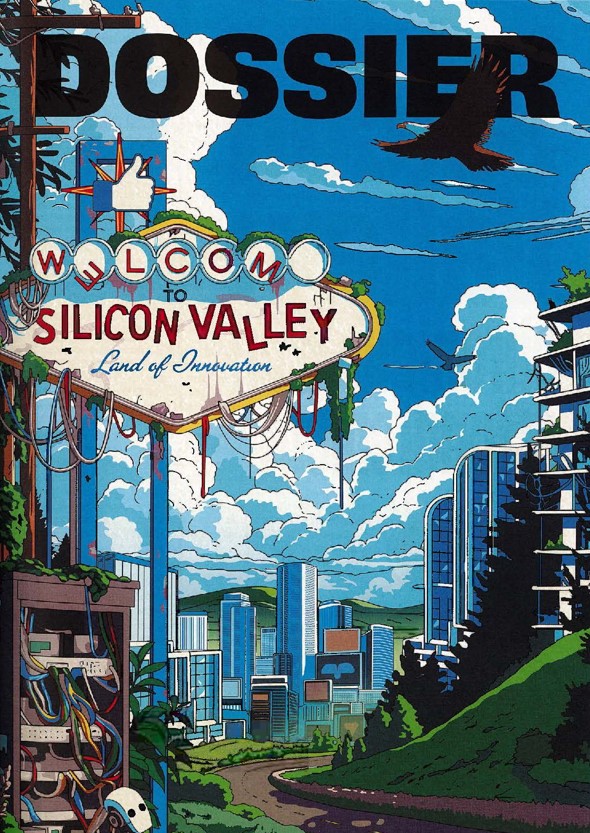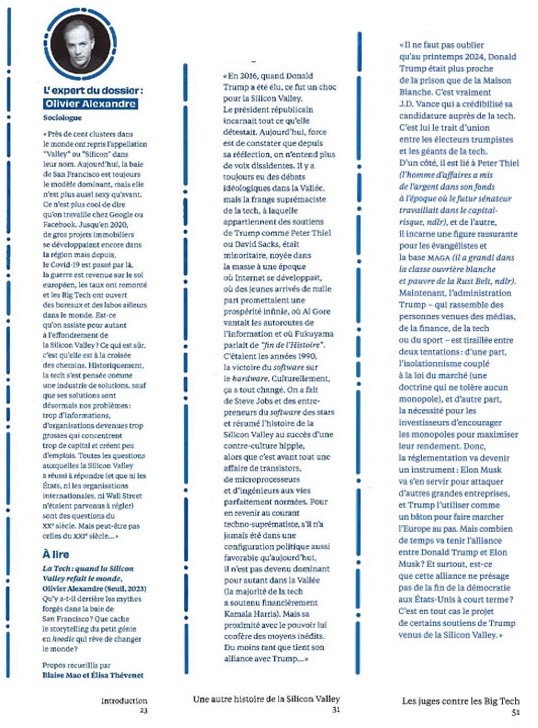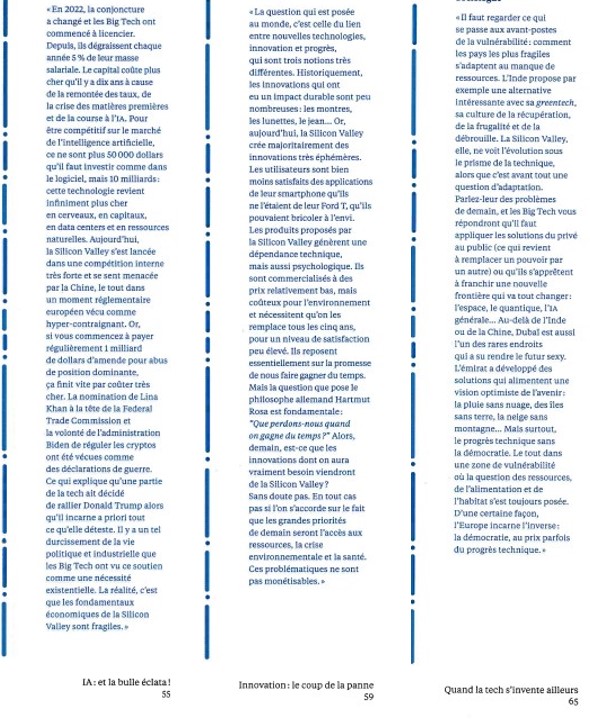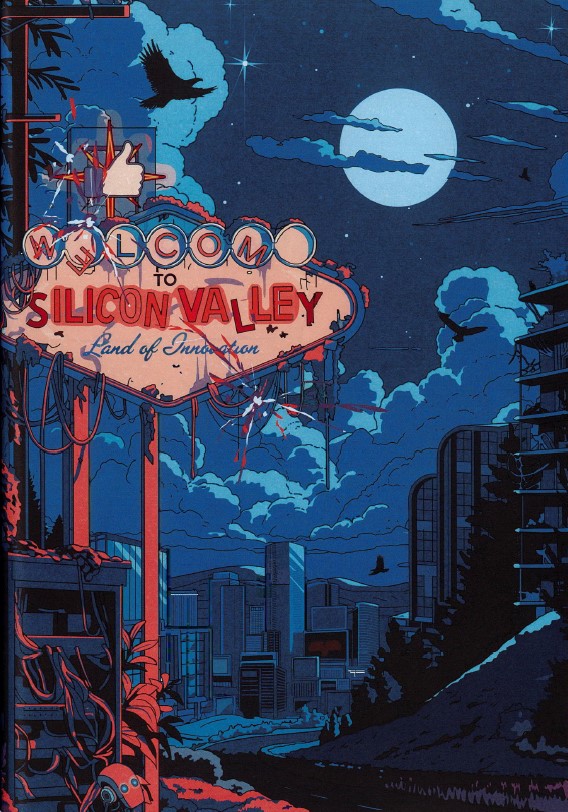Excellent issue of FUTU&R, the magazine by Usbek & Rica, which main feature is entitled Silicon Valley, Chronicle of a Collapse. It’s not a good time to be a fan of the region these days. If you follow my blog, you’ve seen my struggles to understand what’s going on there. This issue contributes to this, and you’ll discover dubious characters like Curtis Yarvin, Balaji Srinivasan, Palmer Lucky, in addition to the famous Peter Thiel, Marc Andreessen, David Sacks, and even Larry Ellison. The issue is a bit biased, but that’s the name of the game, since the magazine “imagines how the Tech Eldorado could collapse.”
The magazine had the good idea to add the informed opinion of Olivier Alexandre, often mentioned on this blog, notably as the author of La Tech. I scanned the contributions in low resolution and I hope the magazine will forgive me for this breach of copyright. I obviously encourage you to buy a copy!
I will just comment on what Olivier Alexandre says and I will end this post by discussing a related subject through a fairly recent scientific article, The Role of Universities in Shaping the Evolution of Silicon Valley’s Ecosystem of Innovation (pdf)
“Are we witnessing the collapse of Silicon Valley? What is certain is that it is at a crossroads. Historically, tech has thought of itself as a solutions industry, except that its solutions are now our problems. […] It is clear that we no longer hear dissenting voices. There have always been debates in the Valley, but the tech supremacist fringe, to which Trump supporters like Peter Thiel and David Sacks belong, was a minority, drowned in the mass. […] Steve Jobs and software entrepreneurs have been made stars and the history of Silicon Valley has been reduced to the success of a hippie counterculture, when it is above all a story of transistors, microprocessors, and engineers with perfectly standardized lives.”
Indeed, the region was a republic of engineers, with back-and-forths between fierce competition in a global world and deregulation and occasional isolationism allowing monopolies. In the 1980s, the threat was Japan, and the semiconductor industry had appealed to the Federal State for its survival (after having benefited from the flow of public money at the height of the Cold War in the 1960s.) I recently spoke of my difficulty in finding dissenting voices too.
“In 2022, the situation changed and Big Tech started laying off employees. Since then, they’ve been cutting 5% of their payroll every year.”
On this point, I slightly disagree with the observation. In 2009 and 2013, for example, Google also reduced its workforce by 5%. I had heard that Cisco was shedding 5% of its “lowest-performing” workforce each year. The region was so dynamic that it was rarely discussed. Working conditions have always been “harsh and demanding.” A world of engineers, no doubt. It brought us computers and smartphones, the internet, and therefore opportunities to behave differently. It also contributed to creating immense biases because, without a doubt, the use of science and technology is never completely neutral.
“The question being asked of the world is the link between new technologies, innovation, and progress, which are three very different notions. Historically, innovations that have had a lasting impact are few: watches, eyeglasses, jeans… However, today, Silicon Valley mostly creates very ephemeral innovations.”
Tom Kleiner went further, mentioning the printing press, the steam engine, electricity, and finally the transistor as innovations that changed civilization. This is undoubtedly close to reality.
And Olivier Alexandre adds a beautiful question: “The products offered are essentially based on the promise of saving us time. But what do we lose when we save time?”
And he concludes (provisionally): “Dubai is one of the rare places that has managed to make the future sexy, an optimistic vision of the future: rain without clouds, islands without land, snow without mountains. But above all, technological progress without democracy. All this in a vulnerable area where the questions of resources, food, and housing have always arisen. In a way, Europe embodies the opposite: democracy, sometimes at the cost of technological progress.”
This isn’t the first time that the future of Silicon Valley has looked bleak. For example, you can find AnnaLee Saxenian’s predictions in a post titled Is Silicon Valley crazy (again)?: “In 1979, I was a graduate student at Berkeley and I was one of the first scholars to study Silicon Valley. I culminated my master’s program by writing a thesis in which I confidently predicted that Silicon Valley would stop growing. I argued that housing and labor were too expensive and the roads were too congested, and while corporate headquarters and research might remain, I was convinced that the region had reached its physical limits and that innovation and job growth would occur elsewhere during the 1980s. As it turns out I was wrong.”
There’s no doubt the region is at a new crossroads! But I’m not finished yet, see below.
I promised above to talk about a scientific article dating from 2020. I found its conclusion interesting even if overall the content well-known. So I copy paste :
Silicon Valley—a Metaphor in search of a Structure?
Silicon Valley is a metaphor for a region that lacks a viable governmental structure. It is at the stage of New York, before its 1989 consolidation into a unified city. With the notable exception of the ecology of the Bay, a downside has emerged, a public-private imbalance revealing gaps in housing and transportation Spread across multitudinous counties, towns and cities, Silicon Valley lacks sufficient governance capabilities to address the negative consequences of its overweening success.
An additional imbalance in academic capacities is, in part, a consequence of a more than half century old master plan strictly segmenting the public academic sphere that has limited individual institutional advancement. This gap has been partly redressed by establishment of branch campuses by universities in other parts of the country, like Carnegie Mellon and the Wharton School that ironically treat the region as an under-developed area, at least in its academic capabilities. Moreover, state government funding for public universities
has declined drastically, from providing 40% of Berkeley’s budget in the 1980’s to 14% percent at present. This gap is being redressed by a massive fund-raising campaign that expects to raise 6 billion dollars and increase the universities tenure track positions in coming years.
Re-balancing the Triple Helix will also require increased interaction among the spheres, a phenomenon that has declined in recent decades, placing the long-term innovation and carrying-capacity of the region at risk. The innovative and sustainable economic development of Silicon Valley not only depends on the presence of strong universities, but on how they interact and overlap roles with the other agents of the Triple Helix model, looking for mutually strategic objectives and identifying cross-cutting issues which none of them can adequately deal individually. Interactions between university, industry and government in a highly dynamic and volatile environment, represent a unique opportunity to recover from economic downturn, create new jobs, and promote a prolific, inclusive and economically sustainable development of regions in the long run.




